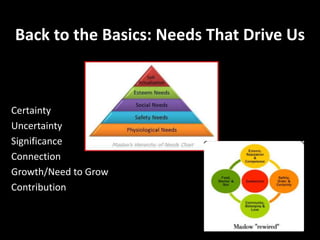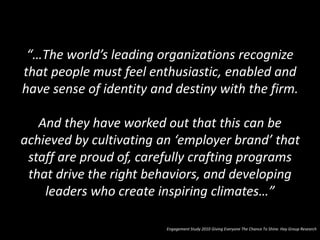High performance teams are worth their weight in gold.
- 1. Leda Karabela www.yhesitate.com Athens 1 How Not To Be Alone (at the top)
- 2. People “…I don’t think you’ll ever replace human judgment and human inspiration and creativity because, at the end of the day, you need to be asking questions like, O.K., the system says this. Is this really what we want to do? Is that the right thing?..” 2 Laszlo Bock, senior vice president of people operations at Google
- 3. Who Leaders “The leader of the past was a person who knew how to tell. The leader of the future will be a person who knows how to ask.” Leadership involves a reliance on other people (co-workers) to achieve objectives. Who better than these same co-workers to help the leader increase effectiveness? 3 Peter Drucker , ‘Leadership is A Contact Sport ” by Marshall Goldsmith & Howard Morgan
- 4. Back to the Basics: Needs That Drive Us Certainty Uncertainty Significance Connection Growth/Need to Grow Contribution 4
- 5. Motivation 3.0 Conventional Thinking Workable? “Reward the Good & Punish the Bad” David & Goliath: MSN Encarta case New Way •Opposite of Control •4 T’s : •Time, •Task, •Technique •Team • Mindset • Pain/grit • “Asymptote” • Meaning thru • Goals • Words • Policies Daniel Pink: The Surprising Truth About What Motivates Us5
- 6. 6 Disruptive Drivers • Longevity, in terms of the age of the workforce and customers – Retiring Later • Smart machines, to augment and extend human abilities – Workplace Automation • A computational world, as computer networks connect – Internet of Everything • New media, that pervade every aspect of life – Online Privacy • Superstructed organizations, that scale below or beyond what was previously possible – AirBNB • A globally connected world, with a multitude of local cultures and competition from all directions- Geek Nation IFTF & University Of Phoenix 6
- 9. What This Means For You How Does It Apply To Your Business? 9
- 10. Who Style Matters Coercive: “Do what I say” demanding immediate compliance Authoritative: “Come with me” mobilizing people to act, offering choice for actions Affiliative: “People come first” building commitment, team harmony/morale Democratic: gives voice /high on fresh ideas Pace Setting: exemplifies himself & sets high standards , demands excellence Coaching: developing people for the future Harvard Business Review , April 2000 Daniel Goleman: Leadership That Gets Results 10
- 11. “…The world’s leading organizations recognize that people must feel enthusiastic, enabled and have sense of identity and destiny with the firm. And they have worked out that this can be achieved by cultivating an ‘employer brand’ that staff are proud of, carefully crafting programs that drive the right behaviors, and developing leaders who create inspiring climates…” Engagement Study 2010 Giving Everyone The Chance To Shine. Hay Group Research
- 12. So, what Does this Really Mean for You? 12
Editor's Notes
- WHAT ARE THE THINGS YOU CANNOT TALK ABOUT ? BECAUSE OF FEAR THEY MIGHT HURT YOUR CAREERS, MAKE YOU LOOK VULNERABLE, NOT CAPABLE…TOO RESISTANT AND HESITANT TO DISCUSS Uncomfortable emotions….hear them, this is how you learn… Comfort or achieve your full potential – you cannot dive in and swim if you are comfortable.
- With an open strategy, decision shifts from if you should be open ... to how open you need to be to accomplish your overall strategic goals. Microsoft said, in effect, “We hired you because you’re smart, because you’re a thinking rational person.” They trusted people to use their best judgment when it came to knowing what to blog and what not to blog. As a result of hiring great people and trusting them, the sandbox at Microsoft is huge.
- ABRAHAM MANSLOW/BRANDEIS: Humanistic Psychology Human beings are motivated by unsatisfied needs, and lower needs need to be satisfied before higher needs can be addressed. While a person is motivated to fulfill these basal desires, they continue to move toward growth, and eventually self-actualization.
- An asymptote is a straight line that a curve approaches but never quite reaches. I wasn’t big into algebra, which Dan Pink says we need here along with a little art history. But without either algebra or art history I get it. I’ll always be pursuing mastery and never possibly getting to an arriving point. As Pink says, “the mastery asymptote is a source of frustration. Why reach for something you can never fully attain? But it’s also a source of allure. Why not reach for it? The joy is in the pursuit more than the realization. In the end, mastery attracts precisely because mastery eludes.”
- Coercive: In a crisis, to kick start a turnaround, or with problem employees Authoritative: When changes require a new vision, or when a clear direction is needed Affiliative: To heal rifts in a team or to motivate people during stressful circumstances Democratic: ‘What do you think?”To build buy-in or consensus, or to get input from valuable employees Pace Setting: “Do as I do, now’ To get quick results from a highly motivated and competent team Coaching: “Try This” To help an employee improve performance or develop long-term strengths
- Remove friction. When you remove barriers and access to information and people, you lower the cost of information-sharing and decision-making and it is also simply easier to do. Think of the time—and money—you can save when an associate or a customer knows who has (or is likely to have) the answer to a question and can make a decision on the spot. Scale efforts. The culture of sharing means information, ideas, and insights spread faster and wider within the organization than when employees have to wait for the official memo. The more accurate information available to people who work in an organization, the less gossip and rumor. In my experience, I’ve found that people who do not know the facts tend to invent something— and it’s usually negative. Enable fast response. The real-time nature of social technologies means that you can respond quickly to the rumor, gossip, or genuine bad news. In fact, if you are not there to head off the growing wave, you risk being overrun. We regularly see leaders trying to respond not to an mishap but to the organization’s attempt to hide it, which, thanks to today’s social technology, is now public. (Think Toyota.) Gain commitment. Probably the hardest to quantify but the most important, with greater openness you win the hearts and minds of your employees and customers.












